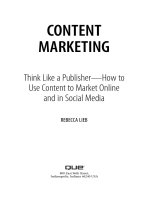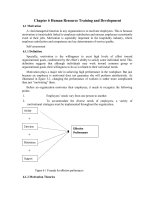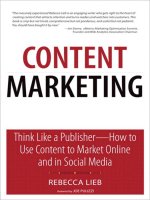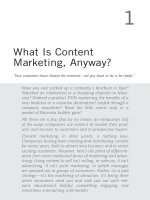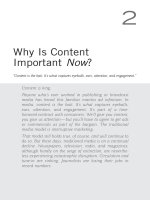Content marketing think like a publisher chapter 6 content that informs and educates
Bạn đang xem bản rút gọn của tài liệu. Xem và tải ngay bản đầy đủ của tài liệu tại đây (1.53 MB, 12 trang )
6
Content That Informs
and Educates
Information is power, and the Internet is where consumers
turn for information. Providing valuable, credible information can be the foundation of a sound business
model—something the earliest online businesses learned
in a hurry.
Take Autobytel, for example. Autobytel, which was
launched in 1995, was the web’s first car-buying website
that supplied consumers with information they’d never
had access to before—how much automotive dealers
paid for new cars. “The dealers hated it,” recalls Thomas
Heshion, a former executive.
Sure, Autobytel will always be remembered as the first
dot-com to advertise during the Super Bowl, but it’s thriving more than a decade later because it supplies information that helps car buyers better understand what they’re
buying and how much they should pay for it. In short, the
information Autobytel provides informs and educates.
28
Part II
W h a t K i n d o f C o n t e n t A r e Yo u ?
Some marketers sell products that are dead
simple. Everyone intuitively gets what they
do. Some examples:
• Combs
• Forks
• Pencils
“Rather than just
selling, companies
are sharing: knowledge, expertise,
and how-to.”
You know what they are. You know how to
use them, and you know why you need
them. No further information or explanations are required.
Then, there’s the enormous amount of stuff that’s just plain more complicated.
Some examples:
• HVAC systems
• High-end stereo equipment
• Enterprise software
• Vintage maps
• Real estate
None of these is an off-the-shelf purchase.
The purchase cycle may be long. The considerations around the value proposition
and product offerings are dizzying and complex. Sure, you can create awareness with
an ad, but often you have to go further. Much further. Potential consumers must be
informed and educated about the products and services. The intimidation factor
must be removed. Often, particularly in B2B environments, buying decisions are a
collaborative process involving groups of people and often multiple business units.
The solution? A content marketing strategy focused on information and education.
The following examples show how a variety of companies—from mom ‘n’ pops to
multinational corporate giants—are leveraging educational and informative digital
content to help consumers navigate their products and buying processes. Rather
than just selling, companies are sharing: knowledge, expertise, and how-to. They
know customers who might not have 30 seconds to spend on watching one of their
ads might gladly surrender 30 minutes to dive into truly useful content.
Example: Wine Library
Gary Vaynerchuk got roped into joining his family business, Shopper’s Discount
Liquors, in New Jersey. It didn’t take him long to realize that many people enthusiastically collected rare vintages. He rebranded the store as Wine Library and
Chapter 6
Content That Informs and Educates
29
launched a fantastically successful ecommerce site in the late ‘90s, increasing revenues from $4 million to over $60 million annually. But he didn’t stop there.
Wine is a complex and to many, intimidating product category. To increase awareness and sales, Gary took it upon himself to educate customers and potential customers. He launched Wine Library TV, a daily video blog that now attracts some
90,000 daily viewers. Gary’s approach to his rarified and somewhat stuffy subject
matter is casual and informal—often bordering on irreverent. One of the over 8,000
episodes, for example, is entitled “What Wine Pairs with Cereal?,” featuring tastings
of vintage wines with entrees such as Cap’n Crunch (see Figure 6.1).
Figure 6.1 Note the separate pairings for Lucky Charms, Cap’n Crunch, and
Cinnamon Toast Crunch in the tongue-in-cheek episode of Wine Library TV.
As his fame grew—in no small part thanks to leveraging the show’s content on
Facebook and Twitter—Gary has been able to entice celebrities to participate in
Wine Library TV. He now has a radio show on Sirius and is a bestselling author.
Example: Corning
Corning produced a corporate video for shareholders extolling the near-future of
high-tech consumer products made of glass. Entitled “A Day Made of Glass,” the sixminute video (that’s a very long running time on the Internet!) was shown in early
2011 at an investor event (see Figure 6.2). Less than six weeks later, it was the mostwatched corporate video of all time, with 8 million YouTube views and climbing
(and a great example of recycling content assets, discussed further in Chapter 23,
“Listening and Responding”).
30
Part II
W h a t K i n d o f C o n t e n t A r e Yo u ?
Figure 6.2 In the not-too-distant future, you’ll be checking news and weather on the
bathroom mirror, according to Corning’s vision of how glass will be combined with technology.
“It breaks all the rules when you think about it,” a spokesman from Corning’s
agency, Doremus, told the media. “It’s six minutes long; it’s not funny, it doesn’t
have celebrities in it, it’s not intended to be sent around to your friends.” But it is a
simple and well-told story, filled with imagination and engaging performances.
Example: Sports Bras
Educational content can also be powerful when it harnesses the authority of an
impartial expert. Social media PR expert Sally Falkow was charged with building
awareness for HerRoom.com, a women’s intimate apparel site. Obviously, in an
ecommerce situation, potential customers can’t try on the merchandise.
To facilitate sports bra buying decisions, Falkow engaged the services of Dr. Joanna
Scurr of Portsmouth University in the UK. Scurr has conducted research into the
dynamics of breast movement and what sports bras work best. The campaign consisted of a highly search engine optimized (SEO) press release on Scurr’s “bounce
test,” as well as a podcast in which Scurr discusses her research and findings. On
HerRoom.com, shown in Figure 6.3, each sports bra product show is actually a
video still. When activated, shoppers can see the actual amount of bounce as models jog in each individual bra.
Chapter 6
Content That Informs and Educates
31
Figure 6.3 Videos and a podcast on the dynamics of breast movement during exercise, delivered by an expert, help women make informed decisions about buying the right
sports bra.
Example: Hubspot
Sports bras do pretty much one thing. What if you’re a technology company selling
a suite of highly complex products that do multiple things? HubSpot is one such
company. It offers a software package that encompasses content and social media
management, inbound lead analysis, email marketing, website management, and a
host of analytics products. Essentially, the company has created a new product category, so even selling to marketers who fundamentally understand most of these
principles is complex.
Because much of what the company does centers around content marketing,
HubSpot practices what it preaches. The company website is a goldmine of information for marketers, featuring original research, videos, a podcast, webinars, white
papers, eBooks, marketing charts and graphs, free online tools, and of course, a blog.
The company also runs communities centered around inbound marketing on
Facebook and LinkedIn, as well as an inbound marketing university.
HubSpot is a content marketing powerhouse, churning out as much, or possibly
even more content around its inbound marketing offering than a dedicated trade
publication would. Of course, that content comes at a price—which isn’t monetary.
32
Part II
W h a t K i n d o f C o n t e n t A r e Yo u ?
To take advantage of the most robust content offerings on the site, which are downloads, the exchange is information. The
downloader supplies an email address,
name, title, and some information about
their business. Yes, if you download some of
its content, you can expect to hear from a
HubSpot rep.
Is it working? In March 2011, three highly
respected companies—Salesforce, Google,
and Sequoia—endowed HubSpot with an
additional $32 million financing round.
That’s not only an endorsement of what the
company is selling, but also how it’s selling it.
HubSpot is a company that’s firmly establishing itself as an authority in its specific niche.
Example: Online
Communities
“Online communities are a tried-andtrue method of
involving customers in products, product
decisions, and
troubleshooting,
creating loyalty
and often adding a
viral, word-ofmouth dimension.”
Condé Nast’s Epicurious is one of the oldest
and best recipe sites on the web. A feature that attracts readers—and repeat visitors—is the community aspect of the site. Readers comment on recipes and add
tweaks or substitutions. It builds loyalty, creates significant amounts of content, and
enhances the overall value of the site.
Online communities are a tried-and-true method of involving customers in products, product decisions, and troubleshooting, creating loyalty and often adding a
viral, word-of-mouth dimension to informative content. These can, of course, be
created by customers with no intervention from a company, but many companies
have elected to invest in the benefits communities create.
Communities can amplify customer feedback, helping sponsoring companies to
better understand their needs and even guide product development. And the customer focus that communities foster reinforces marketing messages by demonstrating an atmosphere of trust, transparency, and openness.
Tech companies have long been at the forefront of informative, educational community efforts. That’s not surprising given they sell complex products to relatively
tech-savvy audiences. Apple Discussions is one of the oldest, containing literally
thousands of articles, tips, and queries of literally every model of computer, server,
iPad, iPhone, monitor, hardware, and software model the company has ever sold.
Chapter 6
Content That Informs and Educates
33
Online communities can save companies a tremendous amount of time, money,
and energy that they would otherwise funnel into customer support. Pauline Ores,
the former head of social media at IBM, created a community customer support
and feedback forum and was then tasked with training engineers to work in this
new channel. Initially, they were reluctant. Yet they quickly saw their workload
drop considerably. “They’re answering each others’ questions!” was one delighted
discovery from a staffer tasked with repeatedly having to respond to customer
queries via email. Often, it was the same queries, over and over again.
SAP is another company that’s developed a successful, robust community. Not only
does it inform the network of developers using the company’s software products, it
contains educational and informative content of its own, such as videos and articles
that help users get the most out of community participation and membership.
Microsoft’s Xbox community is aimed at a number of different target audiences, all
within the purview of console gamers. It offers forums for lovers of music games
and family games, as well as incentives: chances to earn points that can be
exchanged for games, game add-ons, or even renting movies. Of course, it also
helps connect users who want to play games with one another.
American Express created a community in 2007 in which members can help one
another, while helping the world. The company is, of course, a major corporate
donor. The Members Project opens up that process (the transparency part) and
gives cardholders a say in who gets some $4.2 million in charitable donations from
the company.
After registering on the site, participants can vote once a week for a charity they
think deserves financial support. Every three months, five charities are chosen to
receive $200,000 apiece in funding from American Express. Voters are encouraged
to use a broad variety of channels to contact friends to help vote up their choices,
spreading knowledge of the issues, the needs, and the brand’s participation in the
process. The site also provides opportunities to volunteer and donate either time or
credit card loyalty points to worthy causes.
Branded Content That Informs and Educates
Although American Express’s members project certainly is worthy, American
Express is better known for leveraging branded content online in support of its
marketing efforts.
Branded content is content produced by—or sponsored by—one entity rather than
a plethora of advertisers. It’s hardly a new concept. How do you think the soap
opera got its name? Dating back to early radio and television, companies were
wrapping entertainment in exclusive sponsorship. The difference in content marketing is now they’re creating all the content, too.
Part II
34
W h a t K i n d o f C o n t e n t A r e Yo u ?
And they’re learning that if it’s quality informative content (or entertaining content,
as shown in Chapter 5, “Content That Entertains,” visitors will come. And come
back. Because you don’t always have to buy media. You can create it.
Its OPEN Forum is described as “a wealth of resources for business owners—
videos, articles, blogs, podcasts, and expert advice to boost your business.” Aimed
at small business owners, the site (see Figure 6.4) resembles an online magazine
more than it does a marketing initiative with tips on entrepreneurship, marketing,
technology, and money. The only difference? All the ads are for American Express
products. Nonetheless, the site is certainly run like a magazine, with a team of editors and a stable of high-profile contributors, such as well-known web entrepreneurs Guy Kawasaki and John Battelle. (Battelle, not incidentally, founded
Federated Media, the content marketing agency that runs OPEN Forum.)
Figure 6.4 The American Express site for small business owners looks and feels like a
“real” publishing site—and attracts more traffic than many “real” publishing sites do.
American Express considers OPEN Forum successful enough to have launched
what’s essentially a spin-off site. Currency has the same high content standards but
targets a Gen Y audience with lessons, advice, and how-tos on money management:
retirement planning, budgeting, savings, and the like. Both these content sites from
American Express feature everything you’d expect in a high-quality publisher site:
RSS feeds, social media links, an iPhone app, and newsletter subscriptions.
Note
MasterCard Small Business is a similar initiative from one of the direct
competitors of American Express.
No wonder media companies are having such a tough time of it.
Chapter 6
Content That Informs and Educates
35
The most fundamental consumer products have been creating similar online
branded content initiatives for years now. At first glance, Baby.com appears to be a
site about pregnancy and caring for babies. Which, of course, it is. It’s also part of
BabyCenter, shown in Figure 6.5, a family of sites devoted to parent and childcare
issues launched in 1997. It features a community and a whole host of international
sites on the same topics that span the globe from Korea to India to Mexico and
Russia—22 in all. The only thing that differentiates Baby.com from any of the other
well-designed, richly populated, frequently updated sites on the subject is again that
the publisher is also the owner and sponsor; in this case, it’s Johnson & Johnson.
Think babies are a niche market? Indeed, they are, but the niche can narrow in
branded content. Kimberly-Clark makes Huggies diapers and runs a baby and parenting site that reaches into most of the same areas of content as Baby.com. The
Huggies.com brand website features content on every conceivable topic from pregnancy countdowns to feeding and (of course) diapering a new baby and keeping
the tyke healthy, entertained, and stimulated through to toddlerhood. Many of the
articles and features focus on diapers and keeping the baby clean with wipes, but
even more don’t. The goal is brand impressions, brand engagement, and becoming
a trusted source of information for new mothers.
Figure 6.5 Note Baby.com’s email newsletter sign-up box. It allows Johnson & Johnson
to deliver messages that are targeted exactly to an expectant mother’s pregnancy phase.
Branded content can go a lot broader than mothers, babies, Gen Y, and small business owners. Global conglomerates offering a plethora of complex products and
services to highly diverse target audiences are turning to content for many of the
same reasons consumer package goods manufacturers are: engagement, education,
inspiration, trust, and transparency.
36
Part II
W h a t K i n d o f C o n t e n t A r e Yo u ?
Let’s return to IBM. The company distilled its product and services offerings down
to a single concept: A Smarter Planet. Launched as a symposium in Barcelona in
which 600 organizations participated (let’s not forget live events are a form of content marketing, too), A Smarter Planet is now a robust editorial website, as you can
see in Figure 6.6, dedicated to delivering content on a broad mandate of a topic:
“How we use data. How industries collaborate. How we make a smarter planet.”
Figure 6.6 IBM’s Smarter Planet takes care to segment its audience into varying
groups of potential customers and clients.
Doesn’t sound very bite-sized, does it? IBM is perfectly well aware of that. That’s
why all the content on the site is organized into carefully designated industry vertical buckets, such as cloud computing, water, food, transportation systems, healthcare, and so on—all segments the company serves. Content offerings are a robust
mix of articles, research, video, statistics, and opportunities to attend live events.
Much—but not all—of the site content is bylined by top executives at the company,
which helps put faces on what is, after all, a rather monolithic entity.
GE’s Ecomagination is a similar content marketing initiative. It not only promotes
the company’s own green initiatives in light rail, wind farms, and the like but also
leverages community much in the vein of the American Express Members Project
in which participants can submit, discuss, and vote for the best ideas in green, sustainable projects (see Figure 6.7).
Examples of companies that provide digital information to their customers and
prospects are nearly endless. Google publishes some 110 blogs, each corresponding
to a different product or business unit. Almost all are updated several times per
week. Even the U.S. Postal Service (USPS), that stalwart of paper-based marketing,
has put its magazine for direct-mail marketers, “Deliver,” online.
Chapter 6
Content That Informs and Educates
37
Figure 6.7 GE’s Ecomagination encourages user participation and has an open,
breezy, fresh-air look and feel to the site that keeps it in line with its mission.
DeliverMagazine.com contains feature stories and columns, polls, video case studies, podcasts, digital versions of the printed magazine, and a series of marketing
campaigns whose content focuses on issues of concern to the direct marketing
community.
According to a USPS spokesperson, there have been more than 70,000 downloads
from the website, as shown in Figure 6.8.
Figure 6.8 Even that bastion of direct mail marketing, the USPS, recognizes the need
to reach marketers, its target audience, with digital information to educate, inform, and
persuade them to use the USPS.
This page intentionally left blank
